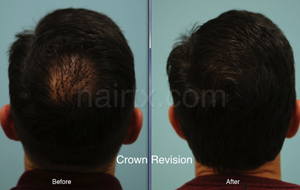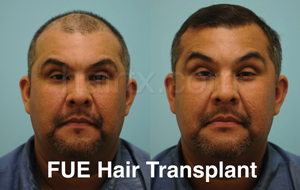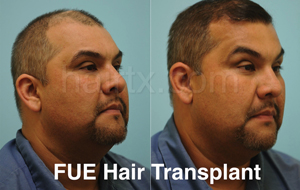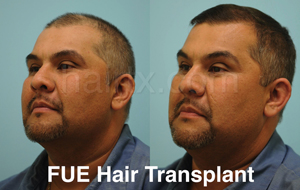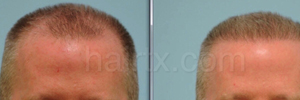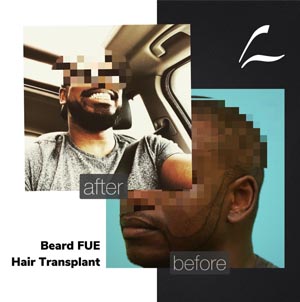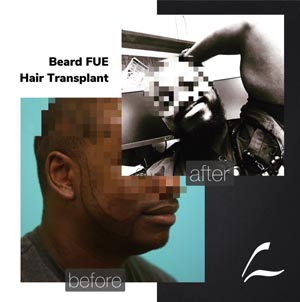What is Follicular Unit Excision/Follicular Unit Extraction (FUE)?
Follicular unit excision (formerly follicular unit extraction), or short FUE, has become the most popular procedure in hair surgery in the world in the past 5 years. There are two major methods of harvesting hairs from the back of the head, the traditional strip method, also known as FUT, and the newer method, known as FUE. Unlike a strip procedure, FUE involves harvesting individual hair bundles with punches that are less than a millimeter in size, carefully selected by Dr. Lam for optimal transplant results while all the while protecting the donor area from where those grafts came.
Contact Us Today! Read Our Manifesto Visit Our Gallery
Virtual Consults
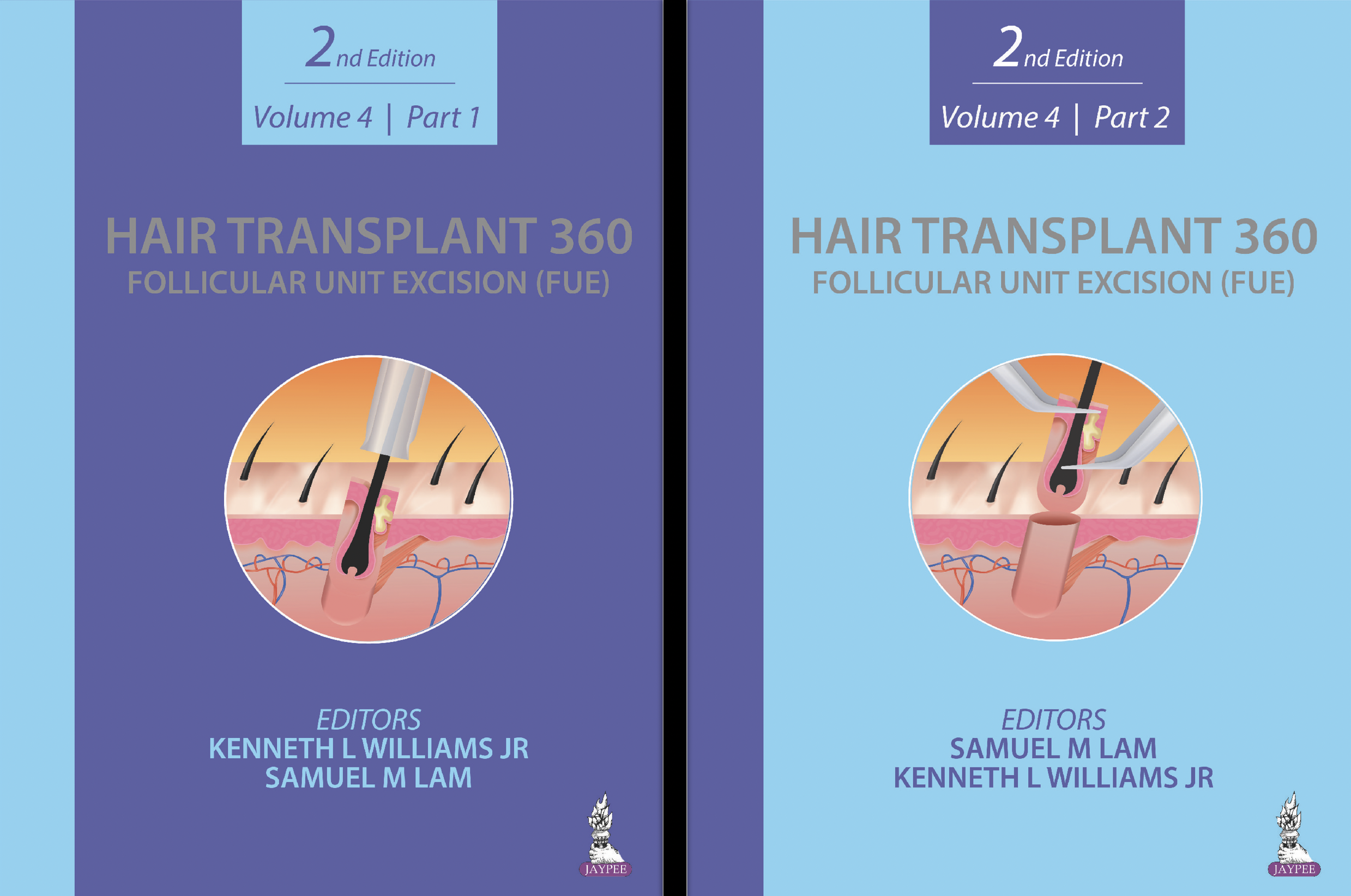
Dr. Lam’s Approach to FUE
Dr. Lam is an expert in FUE and has conceived and completed the only major textbook in the world on the subject, spanning two volumes (over 1,300 pages), released in April 2022, which is a second edition to his first book published only 5 years prior. The reason that he created a second edition so shortly after his first one is that the landscape of FUE has radically changed since 2017 with the introduction of hybrid technology.
Before 2017, there were only blunt systems (for example, the SAFE system) or sharp systems (for example, the NeoGraft or Cole), both of which suffered from higher transection rates of hairs as well as hairs that did not look as good as grafts harvested by the strip method. Hybrid technology, on the other hand, uses a combination of both blunt and sharp elements in a way that is truly unique. Think of a trumpet. A trumpet shape has a sharp outer edge that cuts the tissues cleanly like a sharp device but the inner funnel is blunt facing the graft to limit transection, or injury, to the graft. With hybrid technology, grafts now appear robust, clean, and healthy unlike in the past with much lower transection rates.
Unfortunately, a large percentage of his work now is centered on correcting previously bad work. As mentioned, overharvesting is the most difficult problem to fix, if at all. Only scalp micropigmentation (scalp tattoo) can help improve this situation but not entirely correct it. Dr. Lam does offer this procedure using a needle-less (painless), laser (accurate) device to improve your donor if you have suffered this problem. A second major complication that Dr. Lam sees almost every week is a female hairline design in which the central hairline is rounded to the temples in a feminine shape. Many patients coming to see Dr. Lam actually request this shape because they simply do not know any better. Apparently, physicians untrained in understanding how male hairlines should be shaped also do not know this fact. The only way to fix this problem is to remove those hairs by FUE and laser hair removal. These are only a few of the many problems Dr. Lam fixes all the time following FUE procedures performed elsewhere.
The revolution for FUE took place in 2017-18 and Dallas hair surgeon Dr. Lam’s first edition of his book on FUE written in 2016 was quickly outdated. His new book released in 2022 that covers two volumes and over 1,500 pages discusses this new revolution using hybrid technology. Dr. Lam exclusively uses hybrid technology to harvest grafts, which he performs entirely himself.
Key Points
- Who is an ideal candidate for FUE?
- Men who have hair loss and are diagnosed with male-pattern hair loss
- Men whose hair-loss progression is relatively slow and stable
- Men who wear their hair very short or have donor hair that grows at an obtuse angle (such as some Asian hair) in which a linear scar would not be well camouflaged
- Men who can comfortably shave their head for the procedure
- Is FUE right for you?
When all you have is a hammer the world is a nail. What that means is that if all you practice is FUE, that’s all you can offer a patient and everyone becomes a target for this one procedure. Dr. Lam performs both FUE and FUT (or better described as strip). Many individuals believe that a strip procedure is a horrible dinosaur of a procedure, but Dr. Lam believes in the right patient it might actually be the better option. His strip scars are very hard to see in most cases even when you try to find them by close inspection. He gets the most referrals from hairstylists and barbers who simply cannot find his incisions. The two classic examples of patients who are better for strip are women and men with advanced balding. Women have the best hair in the central occiput (back of the head) and they do not need to shave their head to perform FUE. Men with very advanced baldness simply are unsafe for FUE for many reasons. There are not enough hairs to transplant without overharvesting the donor area. In addition, the hairs border too close to the lost crown area, which means the grafts will be progressively lost over time and the scars revealed.
That being said, there are many individuals who are very good candidates for FUE. Typically, it is ideal for men who like to wear their hair shorter or have less baldness than a Norwood 5-7, i.e., advanced baldness. The answer to who makes a good FUE candidate is a delicate art that requires a detailed consultation with Dr. Lam who can determine how to safely perform a procedure for you. Sometimes Dr. Lam will also use beard hairs into the scalp when there is more limited donor capacity or may combine beard hairs with scalp hairs in certain circumstances. To outline every permutation of what would work for you lies beyond the scope or ability of this introductory text. With 20 years plus of experience in hair surgery, Dr. Lam’s first and foremost goal is long-term safety for your donor hair.
Today’s marketing is focused on numbers for transplantation. Although numbers of transplanted grafts are clearly important to attain a good result, what is as important if not more so is donor preservation. When Dr. Lam harvests your donor hair his ultimate responsibility to you as a patient is to protect the integrity of your donor hair and not to overly deplete it in order to attain a magical number. Most of the hair chains out there proclaim graft numbers that they cannot reasonably achieve without hurting the long-term safety of the donor hair. Dr. Lam heard once that there is a major chain known for splitting grafts in order to attain a higher graft count and actually promoting that as a good thing for patients when in fact that will markedly limit graft survival and visual density. The uneducated consumer can easily succumb to marketing.
Despite all of these negatives in the current industry, Dr. Lam is passionate about delivering safe and aesthetically pleasing results using FUE with his advanced and customized technique. Dr. Lam believes that the time invested in spending with him during a formal consultation and surgery should lead to years of satisfaction with your result. He loves his work and is passionate about transforming lives. He hopes that he will be able to transform yours.
- How to prepare for FUE procedure
- Schedule your procedure and plan on one week for recovery during which you are functional but may not be socially presentable for a week.
- Cut your hair a day or two before the procedure; you should ask for a “high and tight” hair cut that leaves the top as long as you desire but the sides are cut to a “0” guard.
- If you are not already on any hair-loss management therapy and you have miniaturized hairs, you may be required to start one or several (such as finasteride, minoxidil, and/or laser) in preparation for the procedure. Depending on your unique situation, you may be required to be on a hair-loss management treatment for anywhere between 4 to 6 weeks, if not longer, in order to strengthen your hair and to minimize postoperative, temporary hair shock loss.
- If you are from out of town, you will be required to arrive the day before the procedure and will be allowed to travel the day after, staying in town for a total of two nights.
- What is the recovery period?
- You will have visible scabs around transplanted hairs and around harvested sites for about 7 days. You may have swelling of your forehead and around the eyes that may last 3 to 5 days (although this is unlikely in most patients).
- You can wear a hat immediately after the procedure, and you can wash your hair 24 hours after and resume most physical activities 48 hours afterward. You can travel the next day.
- You can wear hairstyling products 2 days after, camouflaging products 7 days after (but before conservative with the amounts), and color your hair 15 days after the procedure.
- Transplanted hairs may start growing 4 months post-procedure, at times (but not always) achieve some visible change in many cases at 5 to 6 months post-procedure, and continue improving in growth up to 12 months post-procedure or longer.
- What are the Risks with FUE?
The greatest problem though with the rise of FUE popularity today is the increase of bad work. Dr. Lam sees almost every day a patient who has suffered terrible outcomes. In fact, he is writing another textbook now, Hair Transplant 101 (his 9th hair transplant textbook), driven by the problems he sees in the industry due to the increasing demand of FUE. Physicians are not deciding who is a safe candidate for surgery but instead the patient meets with a salesperson with no medical knowledge to be sold a surgery. Several times a week he sees patients in consultation who have been offered surgery who should never be given the option for surgery because they will have lifelong problems with that choice. The number-one commitment Dr. Lam gives his patient is the promise of safety, especially when it comes to donor preservation. The most devastating complication that he sees on a weekly basis is overharvesting, where the entire donor area has been over removed and now look moth-eaten. There is no easy fix for this problem. The second aspect to this rise in popularity is that technicians who are unlicensed to perform FUE are doing the surgery rather than the surgeon. Dr. Lam performs all of his own FUE harvesting himself.
- What are the benefits of FUE?
The biggest benefit is that you could possibly shave your hair closer than following a strip procedure since there is no linear scar. (However, Dr. Lam’slinear scars are, for the most part, very hard to detect even with close inspection in most cases). FUE also has the psychological benefit that there is no linear incision on the back of the head.
- What are the costs of FUE?
Dr. Lam does not charge per graft, as he believes that what you are paying him for is his expertise in quality, safe, and painless donor harvesting. He divides his FUE costs by levels and can share with you what those prices are when you come in for consultation.
- Who is performing the FUE? Does Dr. Lam use technicians?
Dr. Lam performs all of his FUE harvesting himself. He does not use technicians or other personnel to harvest grafts. He believes that delegation to unlicensed individuals has become a real problem in the industry today where people are performing illegal surgery with poor results and dangerous outcomes. He sees almost on a weekly basis overharvested donor areas that are unfixable, usually caused by inexperienced surgeons or unlicensed technicians performing the procedure.
- Does Dr. Lam only harvest FUE grafts from the scalp?
No, Dr. Lam also routinely harvests grafts from the beard using FUE. In general, scalp hair has the greatest density and best match to fix scalp hair loss, but beard hairs can be used for other reasons. When there are insufficient scalp donor hairs left, beard hairs provide an excellent source of salvage yielding hundreds if not thousands of grafts. Beard hairs can also be used for a beard-to-beard transplant to place grafts from the beard (usually from under the chin) to other areas of the facial beard or moustache areas (read more). However, Dr. Lam does not believe that body hair is an effective long-term solution, as studies have shown that after 5 to 10 years they will most likely go away not to mention that they lack sufficient density to achieve reasonably good results.
FUE FAQ’s with Dr. Lam
-
Is FUE Painful?Surprisingly, no. At other clinics, you are awake except for maybe an oral pill, so it can be not only painful but also seem like the procedure will never end. With Dr. Lam he uses a gentle mix of intravenous pain control and mild sedation where you do not feel the pain of needles being injected to numb the scalp and you also do not feel the weight of the time passing. This is very unique because Dr. Lam operates out of a Joint Commission accredited surgical facility at his office location that offers him the ability to offer advanced, safe sedation to make your experience uniquely painless.
-
Does FUE Scar?Unfortunately, FUE is not scarless, despite internet marketing hype, which in fact are falsehoods. FUE in the scalp leaves behind little punctate dots that can either be mildly or significantly hypopigmented (less color), which varies from person to person. Fortunately, these dots are very tiny, so hairstyle can oftentimes be worn quite close without these dots being visible. However, since scalp FUE is not scarless, you will be unable to shave your scalp afterward in the future, and this limitation is important to understand. That being said, the beard area is quite unique in that it rarely if ever shows visible punctate dots. That area is practically scarless even in dark-skinned African-American individuals. The body, on the other hand, as a source of FUE will lead to variable hypopigmentation unlike the beard area.
-
How many grafts will be needed?This is always hard to predict and there are many variables that affect the need for graft numbers including the hair caliber, curl, and color-contrast ratio with the scalp. The thicker the hairs, the curlier the hairs, and the less color contrast of the hairs with the scalp will allow for fewer grafts to be used to provide the same level of density. In addition, hairs grow in discrete clusters of 1, 2, 3, and 4 hairs known as follicular units. Some individuals have mainly 2 hair grafts, whereas others who are blessed have mainly 3 hair follicular units. You can imagine that an individual with mainly 3 hair grafts who gets 2,000 grafts will have the same number of hairs transplanted as an individual with mainly 2 hair grafts who has 3,000 grafts transplanted. Further, if there are more zones of miniaturization visible, Dr. Lamwill need to transplant a wider area than initially projected. Unfortunately, in today’s industry it is all about graft numbers and most times the quoted numbers are entirely unrealistic to sell a patient a procedure and that number would lead to a decimated and destroyed donor area in most cases. This is why Dr. Lam’s chief concern is protecting the donor area and getting the appropriate number of grafts to achieve the aesthetic goals with minimal impact on the donor hairs to allow for possible future harvesting and to avoid overharvesting.
-
How long do FUE results last?FUE results should be lifetime in their permanence based on Norman Orentreich’s principle from 1952 known as donor dominance meaning hairs that are moved from one area to another retain the original qualities of the donor region. That being said, there are many factors that go into a result not being as permanent as would otherwise desired. First and foremost is hair loss progression. Even though let’s say you have 1,000 hairs in a prescribed area and you have 500 hairs transplanted into that same area, totaling 1,500 hairs but you lose 500 of the original 1,000 hairs (not the transplanted hairs), then you would be back at 1,000 hairs over time and may again see thinning. That is why medical therapy is so vital in the vast majority of individuals, especially younger men, who need to help preserve their native hairs against hair loss progression.
-
How long does FUE take?In general, the procedure takes about 8 to 10 hours to complete starting from initial hairline design, intravenous sedation, recipient-site creation, donor harvesting, graft placement, to clean up and discharge. Fortunately, because Dr. Lam uses an intravenous protocol patients are usually shocked at the end of the day that they were there all day. During harvesting if you are starting to feel more awake, Dr. Lam adds additional intravenous solution to make you feel more sedated and comfortable so that you do not feel fidgety or feel the weight of time passing. This is a huge advantage that simply put is not performed almost anywhere else.
-
When will the results of FUE be visible?This is variable but you may see some initial results as soon as 6 months or earlier but usually these results are sporadic, and not uniformly full. It takes up to a full year for the majority of the grafts to grow in and sometimes may require up to 18 months for additional small growth to be complete.
-
How soon will new hair grow after FUE?See the answer above but in general usually 6 to 8 months. That being said, Dr. Lam uses ATP/HypoThermosol solution that acts as a regenerative therapy to help with more expedited graft growth. Because of this therapy, he has seen in 5 to 10% of his patients graft growth as early as 4 months following the procedure but this is not that common. Despite early growth, it can still take up to a year or more for a full cosmetic result to manifest.
-
Do the results of FUE look natural?Yes, with Dr. Lam he is razor focused on delivering natural results not only from a casual distance but with close inspection from inches away. There are so many factors that go into a natural result that includes how he designs the hairline, how he distributes and angles the recipient sites (into which the grafts will be placed), and finally into how the grafts are placed into those sites in an atraumatic fashion with the right grafts going into the right sites with proper fit and with the hair curl facing the correct direction. Hair transplant is truly an artistic and technical endeavor that requires the expertise of Dr. Lam, first and foremost, but also an excellent, dedicated team. Dr. Lam has a complete on-site team that is with him full time. He never outsources his technicians or has any assistants fly in to help him with a procedure. Quality control is maintained from beginning to the end of the procedure.
-
Does Dr. Lam perform FUE in women?In general, no. FUE has been overmarketed to women with disastrous results. There are so many reasons why FUE is less ideal for women. First, women need to shave their heads for FUE, which makes no sense. If you undergo a non-shaven technique, that can take up to two days to complete to attain reasonable graft counts, which is miserable for the patient. Alternatively, if a window is shaved or removed, then there can be a discernible reduction in density in the area of the window. Second, FUE by nature will reduce the volume and density of the donor area unlike a strip procedure, which does not. Women hate volume reduction in the back of the scalp. For that reason, it is far from ideal for women. Finally, FUE requires harvesting in zones that are not as dense like the temple area, whereas a strip procedure takes the hair from the best area of highest density. For all of these reasons, FUE in general does not make sense for women.
 Lam Institute For Hair Restoration
Lam Institute For Hair RestorationPhotos
For more Hybrid FUE Before & After Photos, Click here
Please watch Dr. Lam’s SlideShare presentation on his philosophy, strategy, and design for crown hair transplantation.
Please watch Dr. Lam’s SlideShare presentation on the fundamentals of male hairline design.
Please watch Dr. Lam’s SlideShare presentation on recipient site design and distribution.
Schedule a Consultation
Explore your hair-loss treatment options with hair restoration in Plano. Call Dr. Lam today to arrange a consultation with your skincare expert regarding your hair-thinning problems.

